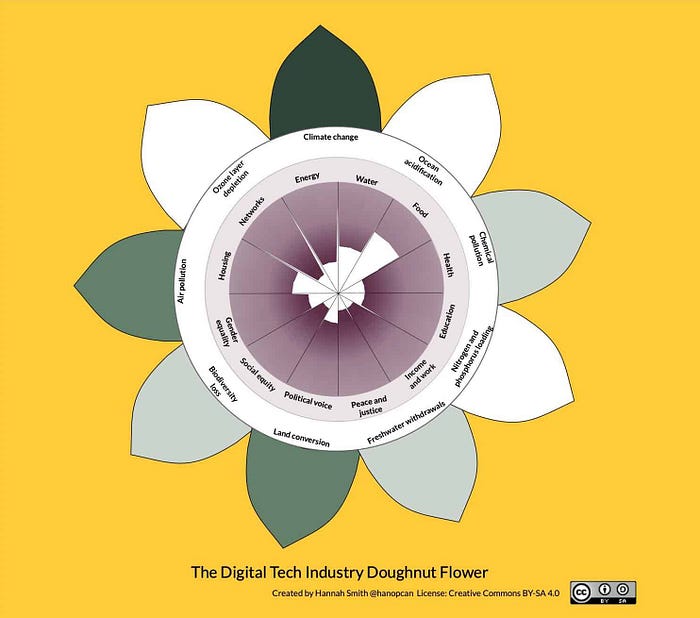Is digital technology part of the climate problem, or its solution?

This weekend I attended the 2024 United Nations Summit of the Future as part of the 2024 United Nations General Assembly programming and Climate Week NYC. The event had three key tracks: digital technology, peace, and sustainable development and finance for sustainable development. The programs, speaker bios, and session recordings are all publicly available to anyone who would like to view them at the links above.
At the summit, I had the good fortune of sitting next to Neal McCarthy, Associate Director of Digital Programs at Oxfam America. I asked him what work he’s most excited about. He told me about the Digital Doughnut model, an excellent example of researchers and practitioners collaborating and building upon one another’s work to create a better world. The irony isn’t lost on me that my most valuable insight from a summit about digital technology came from sitting next to and talking to someone in-person.
During my Masters in Sustainability Leadership at University of Cambridge / CISL, I studied Kate Raeworth’s Doughnut Economics, which she first developed while at Oxfam. Because I’ve worked in digital technology for over a decade, I was excited to hear from Neal how the Digital Doughnut combines sustainable development and digital technology. When I got home from the summit, I read about the model. Below I share an abbreviated explanation of its structure and insights.
Digital Doughnut Model
Kate Raeworth developed the theory of Doughnut Economics. The outer ring of the doughnut consists of the ecological ceiling (maintain balance in the natural world that supports life). The inner ring of the doughnut consists of the social foundation (the minimum standards that we need to live a healthy life). The sweet spot, the doughnut itself, exists in the space between the rings where our societal needs are met, and nature’s boundaries are respected.

Developed by Hannah Smith and Alistair Alexander, the Digital Doughnut is an emerging idea, applying the Doughnut Economics model to the digital technology industry. The Digital Doughnut explores 3 key areas: 12 social foundations (based on the UN’s 17 Sustainable Development Goals), 9 ecological ceilings (planetary boundaries developed by the Stockholm Institute), and 7 ways to transform our thinking and imagination (also developed by Kate Raeworth).
In their 2022 pilot workshops, Hannah and Alistair worked with digital technology professionals to:
- explore a broad definition of sustainability;
- look deeper into the root causes of what is going wrong and how the digital technology industry has been culpable in eroding sustainability;
- imagine a better future for the industry and actions that the digital technology industry can take to create that better future for all.
The Doughnut Flower
The workshop discussions and insights led to the creation of The Digital Tech Industry Doughnut Flower. It shows which social foundations and ecological ceilings were most related to the digital tech industry.
The diagram helps us see all social foundation dimensions were relevant to the attendees, especially income and work, networks, peace and justice, and social equity. Education, energy, gender equality, health and political voice were also prominent. Food, housing and water were discussed but not to the same degree as the others.
Of the ecological ceilings, not surprisingly, climate change was a very strong topic of discussion amongst the ecological boundaries. Air pollution and land conversion were the next dimensions to receive the most attention. Biodiversity loss, freshwater withdrawals and chemical pollution were discussed to some degree in most of the workshops. Ozone depletion, ocean acidification and nitrogen/phosphorus loading were barely discussed at all, and attendees generally did not see much or any connection between these boundaries and the impacts of digital tech.

Discussion themes
Three main themes were brought up in the workshops. These theme were woven throughout all of the discussions.
- Issues around gender/ethnicity, especially pay inequality and exclusion. differentials of pay, but also exclusion were major concerns of participants. These issues were clearly seen by many attendees as essential — and central — to any meaningful discussion on sustainability.
- Work culture was a theme, with “toxic” tech culture referred to repeatedly, as well as exploitation and overlong work hours.
- Quality of life issues, and in particular our unhealthy relationship to technology that drive addiction to tech and disinformation.
Solutions
The workshops then moved to discuss possible solutions. These solutions showcase four solutions of how the digital tech industry can mitigate its challenges and contribute to a more sustainable world.
- Stop the relentless consumption/depletion of resources — attention-based revenue is driving the wrong behaviors.
- Pointless — and endless — growth is getting us nowhere — the exponential growth bubble needs to burst.
- Build things that last and can be reused — the strategy of planned obsolescence only serves shareholders and not society.
- Detoxify tech culture — replace with fairness, inclusion and better ways of working.
Open-source resources for all to use
Hannah and Alistair have generously shared an enormous amount of information on this idea and the resources for these pilot workshops on the website https://doingthedoughnut.tech/. They welcome anyone to use all of these resources to run a similar workshop. All they ask is that the materials be attributed to Doing the Doughnut Tech Creative Commons BY-SA 4.0.
What’s next
Reading through their website, I’m considering how the Doughnut Economics model could be applied to the strategy and operations of any organization in any industry that seeks to make sustainability its foundation. In my own work at Double or Nothing Media, I’m developing a proof of concept for a new company focused on rewilding and in the research phase of developing a food waste mitigation tech platform. How might you use the Doughnut in your work? I’d love to hear your thoughts in the comments.